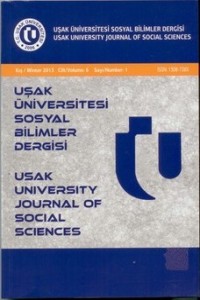Yıl 2013,
Cilt: 6 Sayı: 1, 1 - 8, 01.06.2013
Öz
exceptions can be identified in the international motif indexes and their motif numbers can be ascribed to these miracles. Here are some motif numbers of the folk narratives and those of the corresponding miracles
Anahtar Kelimeler
Kaynakça
- Boratav, P. N. (1960). Vestiges oghouz dans la tradition bektaşi. Acten des XXIV. International des sciences anthropologiques et ethnologiques, tome II, Paris: 141-148.
- Eberhard, W. - Boratav, P. N. (1953). Typen Türkischer Volkmarchen. Wiesbaden.
- Evliya Çelebi Seyahatnamesi.(2006). İstanbul: Topkapı Sarayı Kütüphanesi yazması.
- Gökyay, O. Ş. (1973). Dedem Korkudun Kitabı. İstanbul: Millî Eğitim Bakanlığı Yayını.
- Gölpınarlı, A. (1958) Vilayetname, Menakib-ı Hacı Bektaş-ı Veli. Inkilap Kitabevi, Istanbul.
- Hasan M. El-Shamy. (1995). Folk Traditions of the Arab World. - A Guide to Motif Classification- II vols. Indiana University Press. BloomingtonIndianapolis.
- Hasluck, F.W. (1956) Christianity and Islam Under the Sultans. II volumes. New York: Octagons Books.
- Knappert, J. (1985). Islamic Legends, 2 vols. Leiden, E.J.Brill
- Köprülü, M. F. (1929). lnfluence du chamanisme turco-mongol sur les ordres mystiques musulmanes. Istanbul. Zellitch Freres.
- Ocak, A. Y.(1983) Bektaşi Menakibnamelerinde İslam Öncesi İnanç Motifleri. Istanbul: Enderun.
- Rabghūzī, al. The Stories of the Prophets Qiṣas al-Anbiyāʾ. An Eastern Turkish Version. two vols. The text and English translation. Critically edited by H.E.Boeschoten, M. Vandamme and S. Tezcan with the assistance of H. Braam and B. Radtke.. E.J. Brill, Leiden, New York, Köln 1995. English translation by J. O’Kane and M. Vandamme.
- Rohrich, L. (1980). Problems of Dragon Lore. in Folklore on Two Continents. Essays in honor of Linda Degh.ed.,by.Nikolai Burlakoff, Carl Lindahl .Trickster Press. Bloomington, Indiana.
- Thompson, S. (1955-58). Motif Index of Folk Literature. VI cilt. Bloomington, Indiana University Press.
- Yazıcı, T. (1973). Ariflerin Menkıbeleri. Menakıb al-Arifin by Ahmet Eflaki. Istanbul: Hürriyet Yayınları, I intended to argue that in two cultures which are closely associated with history and geography the oldest may be the origine of the new one. It seemed to me logical that the historically ancient motif or narration might be the origine of the following ones. My dear friend Hasan el Shamy cautioned me that this conclusion may not be tenable. Because in the Ancient tale of the Middled east, recorded in the period of Ramses II, 6 th century B.C. some motives which I considered early Muslim motives, are found. These rae Motif no. D1610.18.1.1 Sphink Speaks.
- E 70.1 The dead comes to communicate with the living in dream. V5 1 Image of deity speaks in vision to devotee. V5 1 Sacred person (prophet, saint) speaks in vision to mortal. Masperoel Shamy Ancient Egypt tales. 229-32. Types of the .. Folktale s. 426.
Yıl 2013,
Cilt: 6 Sayı: 1, 1 - 8, 01.06.2013
Öz
-
Anahtar Kelimeler
Kaynakça
- Boratav, P. N. (1960). Vestiges oghouz dans la tradition bektaşi. Acten des XXIV. International des sciences anthropologiques et ethnologiques, tome II, Paris: 141-148.
- Eberhard, W. - Boratav, P. N. (1953). Typen Türkischer Volkmarchen. Wiesbaden.
- Evliya Çelebi Seyahatnamesi.(2006). İstanbul: Topkapı Sarayı Kütüphanesi yazması.
- Gökyay, O. Ş. (1973). Dedem Korkudun Kitabı. İstanbul: Millî Eğitim Bakanlığı Yayını.
- Gölpınarlı, A. (1958) Vilayetname, Menakib-ı Hacı Bektaş-ı Veli. Inkilap Kitabevi, Istanbul.
- Hasan M. El-Shamy. (1995). Folk Traditions of the Arab World. - A Guide to Motif Classification- II vols. Indiana University Press. BloomingtonIndianapolis.
- Hasluck, F.W. (1956) Christianity and Islam Under the Sultans. II volumes. New York: Octagons Books.
- Knappert, J. (1985). Islamic Legends, 2 vols. Leiden, E.J.Brill
- Köprülü, M. F. (1929). lnfluence du chamanisme turco-mongol sur les ordres mystiques musulmanes. Istanbul. Zellitch Freres.
- Ocak, A. Y.(1983) Bektaşi Menakibnamelerinde İslam Öncesi İnanç Motifleri. Istanbul: Enderun.
- Rabghūzī, al. The Stories of the Prophets Qiṣas al-Anbiyāʾ. An Eastern Turkish Version. two vols. The text and English translation. Critically edited by H.E.Boeschoten, M. Vandamme and S. Tezcan with the assistance of H. Braam and B. Radtke.. E.J. Brill, Leiden, New York, Köln 1995. English translation by J. O’Kane and M. Vandamme.
- Rohrich, L. (1980). Problems of Dragon Lore. in Folklore on Two Continents. Essays in honor of Linda Degh.ed.,by.Nikolai Burlakoff, Carl Lindahl .Trickster Press. Bloomington, Indiana.
- Thompson, S. (1955-58). Motif Index of Folk Literature. VI cilt. Bloomington, Indiana University Press.
- Yazıcı, T. (1973). Ariflerin Menkıbeleri. Menakıb al-Arifin by Ahmet Eflaki. Istanbul: Hürriyet Yayınları, I intended to argue that in two cultures which are closely associated with history and geography the oldest may be the origine of the new one. It seemed to me logical that the historically ancient motif or narration might be the origine of the following ones. My dear friend Hasan el Shamy cautioned me that this conclusion may not be tenable. Because in the Ancient tale of the Middled east, recorded in the period of Ramses II, 6 th century B.C. some motives which I considered early Muslim motives, are found. These rae Motif no. D1610.18.1.1 Sphink Speaks.
- E 70.1 The dead comes to communicate with the living in dream. V5 1 Image of deity speaks in vision to devotee. V5 1 Sacred person (prophet, saint) speaks in vision to mortal. Masperoel Shamy Ancient Egypt tales. 229-32. Types of the .. Folktale s. 426.
Toplam 15 adet kaynakça vardır.
Ayrıntılar
| Birincil Dil | Türkçe |
|---|---|
| Bölüm | Makaleler |
| Yazarlar | |
| Yayımlanma Tarihi | 1 Haziran 2013 |
| Yayımlandığı Sayı | Yıl 2013 Cilt: 6 Sayı: 1 |
Adres: Uşak Üniversitesi Sosyal Bilimler Enstitüsü
Telefon: 0276 221 21 60 Faks :0276 221 21 61
E-posta: sosyaldergi@usak.edu.tr


